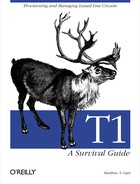Frame relay standardization work was carried out in parallel by the ITU and ANSI. Standards documents often refer to frame relay services as frame mode bearer services. Here is a list of standards:
- ITU Recommendation X.25
“Interface between Data Terminal Equipment (DTE) and Data Circuit-terminating Equipment (DCE) for terminals operating in the packet mode and connected to public data networks by dedicated circuit”
X.25 was one of the first specifications for public data networks. It incorporated hop-by-hop flow control and error correction, which contributed to the high latency of packets through X.25 networks. X.25 is still widely used for low-data-rate connectivity for point-of-sale terminals and similar applications.
- ITU Recommendation Q.933
“Integrated services digital network (ISDN) digital subscriber signaling system No. 1 (DSS 1)—Signaling specifications for frame mode switched and permanent virtual connection control and status monitoring”
The title is a bit wordy, but Q.933 is just the ITU’s LMI specification. Sections of Q.933 refer to ISO/IEC TR 9577.
- ISO/IEC TR 9577
“Information technology—Protocol Identification in the network layer”
This technical report is available at no charge from the ISO. It describes how to identify both ITU-standardized and ISO-standardized protocols in a number of other protocols. It was adopted by the IETF for use with RFC-1490 encapsulation. Unlike most other ISO and ITU standards, TR 9577 is available at no charge.
- RFC 2427 (updated version of RFC 1490)
“Multiprotocol Interconnect over Frame Relay”
RFC 1490 was the first IETF standard for multiprotocol encapsulation over frame relay links. It defines the multiprotocol encapsulation header for different network protocols, plus the encapsulation format for bridged packets. RFC 2427 was an evolutionary update that clarified some minor points and removed the specification of Inverse ARP, among other things. A complete list of changes from RFC 1490 is present in the final section of the RFC.
- RFC 2390
“Inverse Address Resolution Protocol”
frame relay networks may bring new DLCIs into existence dynamically. New DLCIs are reported in the LMI PVC status message with the “new” bit set. These announcements, however, do not include any higher-layer information. Inverse ARP allows a frame relay device to request the IP address associated with a given DLCI.
